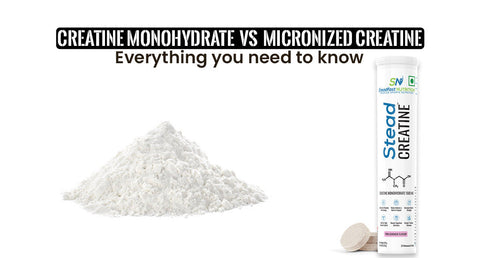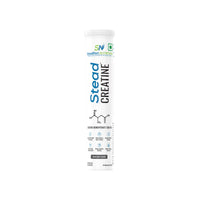Table of Content
Creatine monohydrate is one of the most researched and effective supplements consumed by athletes and fitness enthusiasts to improve their performance. It helps increase lean body mass and endurance when combined with resistance or strength training. Although creatine monohydrate has been a popular supplement, curiosity regarding other forms of creatine is also taking over the fitness commmunity. One of them is micronized creatine. You might be curious about what it is and what makes it better than the monohydrate form. In simple terms, micronized creatine differs from creatine monohydrate mainly in particle size. Micronized creatine has smaller and finer particles, making it more soluble and eliminating the concern about lump formation at the bottom of the liquid. Going forward, we will learn about creatine monohydrate vs micronized creatine - their differences, advantages and disadvantages.
All About Creatine: A Quick Recap
Creatine is a nitrogenous chemical compound naturally produced by our body in the brain and muscles, which regenerates ATP (adenosine triphosphate) to fuel the body with energy. It is made up of three important amino acids: L-arginine, glycine, and L-methionine. Creatine gets transported through the blood to the muscle cells and fuels the muscles during high-intensity workouts to provide short bursts of explosive energy. It also helps retain water in the muscle cells, showing a pump effect or temporary increase in muscle size post-workout, especially during the loading phase. Creatine supplements are one of the safest supplements to use and help enhance exercise performance, build muscle mass, and expedite muscle recovery, preventing chances of injury.
How does it work?
During high-intensity workouts the demand for energy increases in the muscles. Creatine helps the body produce ATP, which provides fuel to the muscle cells to enhance endurance. After getting converted to phosphocreatine, it is used to regenerate ATP in skeletal muscles to maintain energy levels and enhance exercise performance.
Benefits of Creatine
- Promotes muscle gain: Creatine intake helps increase muscle mass due to water retention in muscle cells, which causes muscles to swell and acts as a key stimulus factor for muscle cell growth.
- Speeds up recovery: Creatine supplementation regenerates and increases ATP stores, which helps prevent muscle damage, lowering the risk of injuries after high-intensity workouts and enhancing muscle repair and, consequently, muscle recovery.
- Improves energy levels: The body utilises ATP faster than it produces during exercise, depleting phosphocreatine stores. Creatine supplements help replenish those stores again to fuel muscles for better performance and optimal results.
- Enhances muscle hydration: Retention of water content in the muscles lowers chances of dehydration and curbs muscle cramps caused because of water loss through sweating during intense training. Creatine supplementation helps retain water in the muscles, preventing chances of fatigue and cramps.
What is Creatine monohydrate?
The most common form of creatine supplement used by athletes and other fitness enthusiasts is called creatine monohydrate. It is also one of the most researched forms of creatine that supports muscle building when combined with resistance training. It also helps in improving overall body composition and strength in those looking to enhance their performance. Creatine also helps stimulate muscle cell growth and enhances muscle mass.
How does Creatine monohydrate work?
Creatine monohydrate supplementation is known to significantly increase the phosphocreatine/creatine ratio in the skeletal muscle tissues, resulting in increased capacity for re-synthesis of adenosine triphosphate (ATP) during high-intensity training sessions requiring continuous bursts of energy. Moreover, after consumption of creatine, an increase in muscle pump by improved osmotic pressure retains creatine content in muscle cells. This further results in swelling of muscle cells, retaining water.
Benefits of creatine supplementation in the monohydrate form
- Enhances muscle functioning: Creatine monohydrate has been shown to enhance strength in athletes, powerlifters, bodybuilders, and other sportspersons. It helps replenish ATP stores that increase the availability of energy to support muscle contraction, lowering the risk of muscle damage while performing high-intensity workouts.
- Helps build muscle mass: Consumption of creatine monohydrate can stimulate muscle protein synthesis, which helps build muscles when combined with resistance training. Creatine monohydrate also increases the hydration in muscle cells and helps reduce the breakdown of muscle protein.
- Increases endurance: Creatine monohydrate, when co-ingested with carbohydrates, enhances the re-synthesis of glycogen, an important component to fuel high-intensity aerobic exercises. However, more research is needed to determine the role of creatine monohydrate in enhancing endurance for sports such as cycling, skiing, and mountain biking, which require high surges of energy repeatedly.
What is micronized Creatine, and how does it work?
Creatine that has undergone the process of micronization (breakdown of creatine particles) to reduce its particle size for making it finer and soluble in liquids for faster absorption is called micronized creatine. Micronized creatine offers a higher level of efficacy for those with digestive issues as it eliminates the risk of lump formation at the bottom of the liquid due to its finer particles. However, creatine monohydrate and micronized creatine are equally effective and similar in function. Both provide almost identical benefits, such as increased energy production and boost performance by facilitating the production of ATP in the muscle and brain tissues and enhancing muscle growth and recovery.
Specific benefits of creatine supplementation in the micronized form:
- Highly Soluble: The smaller particle size of micronized creatine leads to quicker solubility and easier mixing in liquids, resulting in the elimination of coarse-grainy texture at the bottom of the solution and making it more soluble than the monohydrate form.
-
Easier to absorb: Micronized creatine has a smaller particle size, which makes it highly soluble in water, thus improving the body’s ability to potentially absorb it faster. The micronised form promotes faster release of creatine to muscles resulting in better absorption and utilisation.
Creatine monohydrate vs. micronised Creatine: Differences
Micronised creatine is smaller in size and finer in composition than creatine monohydrate. It needs to be understood that both are creatine monohydrate only but the micronised one is a little more milled for reducing the particle size. While creatine monohydrate may take a slightly longer time to dissolve in water, micronized creatine dissolves more easily. Micronised creatine can be absorbed faster by the body than creatine monohydrate. However, creatine monohydrate is considered clinically more safe and effective and the best form of creatine, as there are several studies to back it up in comparison to the micronized version.
Creatine monohydrate vs micronized Creatine: Similarities
Creatine monohydrate and micronized creatine both share the same active ingredient - creatine, which has similar effects on the body, i.e., enhanced training performance resulting in muscle growth when combined with resistance training. Thus, to choose the best creatine supplement, such as Steadfast Nutrition’s “SteadCreatine,” to maximize gains without compromising on quality and efficacy always choose a reputed brand.
Creatine monohydrate vs micronized Creatine: Usage
Generally, taking creatine in either form - micronized or monohydrate - before or after a training session may give optimal outcomes because that is when it is most required by the body for energy production in the form of ATP and recovery. However, there is no consensus on the exact timing for taking a creatine supplement.
Conclusion
To conclude, creatine supplement in the monohydrate form is one of the most used supplements by athletes and fitness enthusiasts to enhance their performance and boost energy levels. Studies suggest that creatine supplementation in the monohydrate form is the best form of creatine. It not only promotes muscle growth but also stimulates fast recovery. However, more research is required to know about some specific benefits that micronized creatine has to offer. There are certain myths regarding bloating associated with creatine supplements due to their water-retaining property, but the fact is that it keeps muscle cells hydrated. Thus, it must be consumed in the required dose of 2.5-5 g/day to avoid the potential side effects. In case of any pre-existing kidney or liver conditions, one must always consult a health care provider before starting a creatine supplement.
FAQs:
Can I consume both Creatine monohydrate and micronized Creatine together?
Although there is no research indicating why you shouldn’t be allowed to consume both forms of creatine together, it is unnecessary to do so, as both of them will yield similar results. Also, consuming both together may lead to overdose, so one should consult with a healthcare professional before opting for one of them for effective results.
Which one is more effective? Creatine monohydrate or micronized Creatine?
Both monohydrate and micronized forms of creatine are said to be highly effective, but there is more research and study about the monohydrate form, which makes it a better and safer option to opt for. Moreover, creatine monohydrate is a well-researched ergogenic aid in the fitness industry and boosts ATP production, increasing exercise performance.
In what dosage should I take creatine monohydrate and micronized Creatine?
3-5 g of creatine in any form is deemed safe to consume. However, some people also go on loading phase where the dosage is significantly higher to 20-25 g daily for 5-7 days before going back to the maintenance phase. However, one should always consult with a healthcare provider before administering it.
What are the main differences between micronized Creatine and monohydrate Creatine?
The major difference between the two forms of creatine is that micronized creatine has smaller and finer particle size structurally which is potentially more quick to dissolve and absorb, making the micronized version impart better solubility.
Why Should I Choose Steadfast Nutrition’s Creatine?
Steadfast Nutrition’s SteadCreatine is the best creatine supplement available in the market, which comes in easily dissolvable effervescent tablet form. It delivers 1500 mg of creatine monohydrate and is the best supplement for those indulging in high-intensity activities. It is undeniably effective and suitable for those seeking to improve performance and accelerate muscle recovery.
How does the absorption rate of monohydrate Creatine compare to micronized Creatine?
The particles of micronized creatine are smaller in size; hence, they are faster to absorb in comparison to monohydrate form. Because the absorption and utilisation of creatine is faster it replenishes energy stores faster through ATP production.
Are there any negatives to micronized Creatine?
If taken in higher doses, micronized creatine may cause gastrointestinal or digestive issues. Overdose of creatine for a long time may lead to the risk of kidney damage but more research is needed to know any other possible negatives to it.


